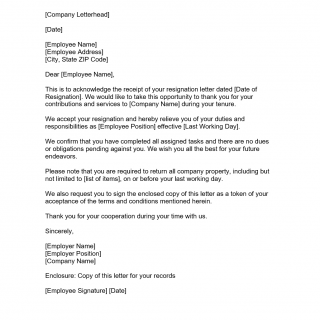Relieving Letter
A relieving letter is a document that is issued by an employer to an employee who is resigning or leaving the company. Its main purpose is to formally acknowledge the employee's resignation and to state that the employee has completed all of their duties and responsibilities.
The relieving letter consists of a few key parts, including the employee's name, the date of resignation, the last working day, and a statement confirming that the employee has completed all assigned tasks. The letter may also include details about the employee's performance and conduct during their time with the company.
The parties involved in the relieving letter are the employer and the employee. It is important to consider state-specific requirements and regulations that may apply when compiling the letter.
When compiling the relieving letter, the employer will need to have certain data about the employee, such as their name, position, and date of resignation. The employer may also need to attach additional documents, such as the employee's contract or agreement.
An application example of a relieving letter is when an employee resigns from their current job to take up a new position with another company. In this case, the relieving letter is required by the new employer to confirm that the employee has completed all their duties with their previous employer.
The strengths of a relieving letter are that it provides a formal acknowledgment of the employee's resignation and can be used as proof of employment. A weakness can be that it may include details about the employee's performance and conduct, which may be negative.
An alternative form to a relieving letter is a certificate of service, which is a document that confirms an employee's tenure and position within a company. The difference between the two is that a relieving letter is issued when an employee resigns or leaves the company, while a certificate of service can be issued at any time during an employee's tenure with the company.
The relieving letter affects the future of the employee as it can be used as proof of employment and can impact their chances of securing future employment. The letter is typically submitted to the employee upon their last day of work and is stored in their personal file. It may or may not need to be notarized, depending on the company's policies and state regulations.

